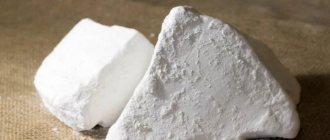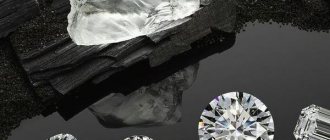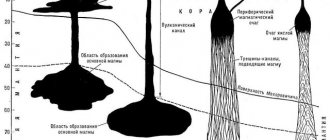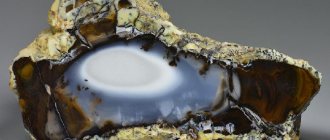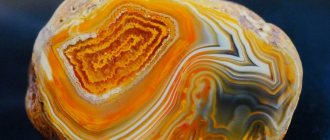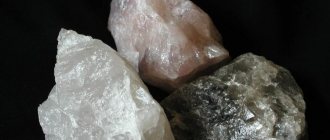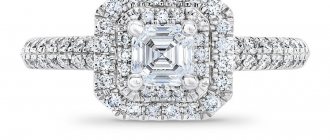A huge amount of semi-precious stones and minerals are mined in the world, many of which, due to the same origin, are similar in appearance. A striking example of twin stones are agate and onyx - striped minerals that are difficult to distinguish from each other to an uninformed person. Trusting buyers are misled by sellers selling black onyx - agate colored in a dark shade or obtained naturally. Before agreeing to the persuasion of sellers who claim that there is no difference between the stones, you should find out how they differ.
Agate and onyx: are they the same thing?
Sellers in jewelry stores, in the absence of one mineral, often offer another, assuring that agate and onyx are the same thing. However, this is not so: minerals are close relatives and have much in common, but still differ from each other. To understand the difference between stones, you should study the characteristics in more detail.
Agate and onyx are classified as ornamental minerals, which have always attracted people's attention with their beauty and patterns. Both stones are considered a variety of layered chalcedony. In terms of physical properties and chemical composition, gems have much in common:
- equal hardness;
- resistance to acids;
- transparency around the edges;
- the set of color tones is similar;
- density over 2.6 g/cu.m. cm.
The minerals are not identical. The main, but not the only, difference between gems is their color.
Stone jewelry
Jewelry will release energy more effectively if you wear it constantly. But with such a long-term contact, a person’s character may become a little tougher, and thoughts about getting rich by any means will arise in his head.
To avoid the negative effects of the mineral, you need to give it a rest for a couple of days.
Onyx is considered a winter, autumn stone, so it is especially recommended to wear it in cold weather. The mineral has a varied color palette, so you can choose jewelry for any occasion. It will complement your image, making it more interesting and mysterious. Best suited for middle-aged and older women.
View this post on Instagram
Publication from Jewelry Exhibition I FIBULA (@decor.for.women) Jun 17, 2022 at 7:10 PDT
View this post on Instagram
Publication from Gallery of jewelry February. (@alenajewelry) Jun 17, 2022 at 1:14 PDT
Product care
To prevent the gem from fading and losing its attractiveness over time, you need to remember some features in handling:
- Keep the stone in a separate case or bag from others to avoid accidentally scratching the surface.
- Do not expose the stone to aggressive household chemicals or prolonged exposure to the sun.
- For cleaning, use polish and special solutions. Ordinary water will not harm the stone, but it will not cope with dirt. You can clean the mineral using traditional methods: wipe it with bread crumbs or brush it with soapy water.
What is the difference between agate and onyx?
To understand the differences between stones, you should take into account the following details:
- In agates, the contrast of layers is weakly expressed, the boundaries between the lines are inconspicuous.
- The pattern of agates is a unique pattern - each stone is original, and there are no two copies with the same pattern in nature. Onyx has parallel rather than ring-shaped lines.
- The luster of agates is matte, while that of onyxes is glassy.
- The agate is not transparent, but is slightly translucent at the ends. Onyx has the same qualities, but less pronounced.
- Agate deposits are located in India, Russia, Georgia, and Armenia. Onyx stones are mined in America, Brazil, Uruguay, Algeria and Mexico.
- Natural striped gems do not come in one color. The agate palette includes lemon, crimson, pink and other shades. Ordinary onyx is decorated with dark and light stripes, but some specimens are decorated with scarlet, gray or brown inclusions.
Who is it suitable for?
- Suitable for people of any creative professions.
- The gem does not like narrow-minded and complex people, and sometimes refuses to work with them.
- Students during the busy period of the session.
- Businessmen at negotiations.
Zodiac signs
- Needed by Geminis of the first decade.
- Sardonyx is indicated for Aquarius, Sagittarius, Gemini.
- Contraindicated for Virgos and Cancers.
Every Earth sign can count on the help and support of onyx.
Taurus, Scorpio, and Capricorn will easily establish contact with onyx.
Is Onyx right for you?
Not really
Element
Earth
Planets
Venus
Pluto
Uranus
Mars
Mercury
Energy
Jan
Types of minerals
Both minerals are divided into many varieties. Classic agate is a stone with blue-gray and light layers that form a beautiful pattern. The group of agates is divided into varieties depending on the patterns:
- ocellar;
- star-shaped;
- cloudy;
- ruinous;
- tape;
- landscape;
- sapphirine (blue);
- iridescent.
Onyx is also divided into types depending on color and pattern:
- Arabic - black and white mineral;
- carnelian - red and white lines;
- sardonyx - specimens with brown and light stripes;
- chalcedonyx is a gray-white mineral;
- Onyx is a stone with alternating light and dark gray lines.
Separately, mention should be made of the popular variety called black onyx. In nature, an absolutely black stone does not exist; there are dark specimens with faint layers. Black onyx is just a trade name used for agates.
All-coal mineral is obtained in two ways:
- Coloring. In ancient times, carbon was used to impart a charcoal color; now cobalt nitrate is used.
- The natural way . Sometimes you come across agates in which the thickness of the dark layer is several cm. To obtain black onyx, this dark layer is cut and processed. However, it is important to note that calling such a stone onyx is incorrect, because the word “onyx” implies alternation, and not a single color.
STRUCTURE
The crystal structure of onyx, like other polymorphic modifications of quartz, is characterized by the peculiarity that the Si4+ ion is always in a quadruple environment of O2- ions located at the vertices of the tetrahedron. Each vertex of such a tetrahedron simultaneously serves as the vertex of another adjacent tetrahedron. Thus, the crystal lattices of these minerals consist, as it were, of frameworks of tetrahedrons linked to each other. The method of coupling in all modifications is the same (through the vertices of tetrahedrons), but the orientation and general symmetry in their arrangement are different. In general, the packing of oxygen ions is not dense: the frameworks have “voids” between the tetrahedra. In low-temperature modifications they are small in size, and in high-temperature, more “loosely” constructed modifications they are larger.
Onyxes (siliceous geodes) have a concentrically zonal structure, caused by the intermittency of differently colored layers of chalcedony and sometimes quartz. The central parts of geodes are often composed of crystalline-grained quartz, sometimes in the form of brushes of crystals.
History and origin
Another difference between the layered beauties is the history. Stones have been known to mankind since ancient times, and the history of each representative is interesting and informative.
The mineral onyx gets its name from the Greek word “onychion,” which translates as nail.
According to Greek legend, Aphrodite's son, Eros, was somehow playing around and hit his mother's finger with an arrow, from which the nail fell to the ground, turning into a striped mineral of amazing beauty. From Arabic the name is translated as “sad”, since the stone was often used to decorate tombs, for example, the Gur-Emir mausoleum in Samarkand.
The history of agate is no less interesting. According to the first version, the name of the mineral is translated from Greek as “useful” or “lucky.” Another version says that the gem received its name from a river in Sicily - Ahastes (Dirillo).
The stone has been known to people since ancient times; proof of this is a ship built BC. e., the floors of which were covered with agates and other minerals. Striped stones were prized by the Sumerians and Egyptians - they were used to create jewelry that was found in Sumerian cities and the tomb of Pharaoh Tutankhamun.
The origin of the gems is the same - presumably volcanic. Rocks form in the voids of solidified lava through diffusion. According to another version put forward by scientists, minerals owe their appearance to silicic acid and solutions settling in rock cavities.
Healing properties
Onyx affects the body as follows:
- Heals wounds. In ancient times, powder was used for this. They sprinkled it on the wound to prevent infection and speed up recovery. For quick healing, it is enough to wear jewelry.
- Treats the oral cavity. Powder is also used for this. You can rinse your mouth with water infused with gems. It will have a disinfecting effect and slightly reduce pain.
- Helps you lose weight. To speed up metabolism, drink water infused with the mineral. This remedy can improve the condition of some hormonal disorders and autoimmune diseases.
- Relieves headaches and high fever. When applying onyx to the forehead or taking an infusion, the person’s condition is alleviated. This is especially effective for causeless pain, increased reaction to the weather, atmospheric pressure, etc.
- Improves diction when stuttering. Black stones are used for treatment.
- Increases potency. It is better for men to use red varieties for these purposes.
- Fights absent-mindedness. Gems direct energy to accomplish important tasks, prevent distractions and promote concentration.
- Treats oncological pathologies, cardiovascular diseases, rheumatism and liver diseases. In some cases, onyx alleviates the condition of renal colic.
Only natural minerals have healing properties. Imitations and fakes are not used in therapy. For treatment, they try to keep the talisman as close to the problem area as possible. For example, in case of heart pathologies, pendants with red gems are worn. An onyx egg is used for massage.
Onyx helps strengthen and heal the spine
The stone has a general beneficial effect on the body. It helps fight laziness, inspires optimism, and restores the desire to live. The mineral treats depression and increases stress resistance. They complement therapy for addictions.
Specimens with better magical properties have denser stripes on the surface.
Areas of use
Striped minerals are used in the same areas: stones are used to create jewelry, candlesticks, seals and for interior decoration. In addition, they are valued and loved by esotericists, magicians and healers.
What are striped varieties used for:
- Since ancient times, onyx There are references to such decorations in the Bible. The most famous example in the world belonged to Benvenuto Cellini - the Last Supper is depicted inside the colored stone.
- Agates are used to create mortars and pestles for chemical experiments, prisms and stones for scales and watches, jewelry, dishes and figurines. A huge dish is kept in the Austrian Kunsthistorisches Museum - the diameter of the product is almost 0.75 m. In the Middle Ages, the mineral was ground into powder and treated for patients from snake or scorpion bites.
If you don't want a fountain, take a ring
In ancient times, marble onyx was especially popular. It was used for cladding the interior of palaces, for stone-cutting products - sculptures, sacrificial vessels and bottles.
Stone is readily used by stone cutters to create small glyptic items (boxes, candlesticks, ashtrays).
Of course, jewelers could not ignore such beauty.
Those who can afford it make countertops, wall panels, and onyx floors in their homes. You can rest assured that it will look “expensive and rich.”
Onyx floor
In landscape design, the gem is used to make fountains, statues, vases and flowerpots.
For those who like to buy building materials abroad: beyond the “hillock” onyx is called marble onyx (and it, by and large, does not belong to onyx).
And marble onyx in the catalogs of some companies is referred to as alabaster (alabastrite). This is completely wrong.
What is more expensive: onyx or agate
Despite their uniqueness and amazing beauty, onyx and agate are not precious stones. Many collectors do not pay attention to this and are happy to add valuable specimens to their collections.
The cost of agate, given the beauty of the stone, is modest. The price of a natural mineral will be up to $2 per gram, with a maximum of $110–220 per pebble. However, it is important to note that rare agates with a unique color or design are more expensive. When purchasing jewelry, the cost will be affected by the type of metal and inclusion of other stones.
Compared to agate, onyx is an expensive mineral, as it costs twice as much.
Onyx and agate are two close relatives that share many similar features and characteristics. But despite similar qualities, striped minerals are different - differences are manifested in color, density and luster.
How to spot a fake
The question of how to distinguish natural agate from a fake has become relevant, since instead of jewelry or a talisman with a real mineral, you can purchase a product with an artificial or synthetic stone :
- artificial gems are made from stone chips;
- In the production of synthetic gems, plastic resins and plastic are used.
Here are a few ways to distinguish real onyx from a fake:
- take the stone in your hand; if it is synthetic, it will heat up in a couple of seconds, and if it is natural, in 30 seconds;
- With an ordinary sewing needle you can identify an artificial gem; when pressed, a scratch will appear , but the surface of the real stone will not be damaged.
Amulets with painted natural stones lose their magical power; they are identified by visual signs: unnaturally bright colors, absence of lighter stripes, contrasting transitions between layers.
Jewelry with agate protects the owner from envy and negative energy. The design and color range of the products is amazingly diverse. A woman with any type of appearance can find an accessory that matches her style . Additional information about these gems can be found in the video:
MORPHOLOGY
Onyxes, on the one hand, differ from chalcedony - monomineral non-zonal accumulations of this mineral, including its colored varieties, and on the other hand, from hydrothermal jaspers, sometimes found in close association with agates, genetically related to basic and intermediate volcanics, which are dense chalcedony formations containing quartz, quartz and various mechanical impurities - goethite, hematite, celadonite, chlorite and others, the content of which reaches 20-30%, and are opaque even in thin fragments. Such jaspers can form separate parts of agate geodes or form interlayers in them.
(2 ratings, average 4 out of 5)

